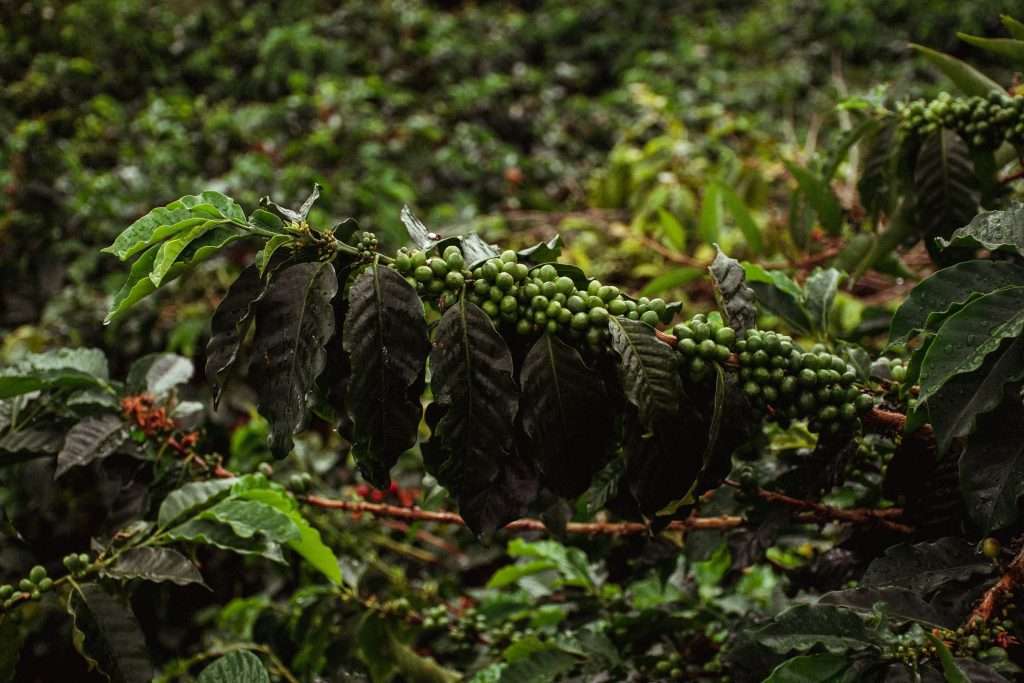Ever wondered why Colombian coffee has such an alluring reputation? Let’s dive into what’s happening behind the cup. Colombian coffee owes its acclaimed status to more than just a famous label. Its magic starts in the mountainous terrains of Colombia, where only the finest Arabica beans are grown. These beans aren’t just randomly chosen; they’re cultivated in coffee landscapes that have earned the honor of being UNESCO World Heritage sites.

Coffee plantations in Manizales, Municipality of Colombia. Credit Image pixbay
Once the beans are harvested (and we’re talking about good old-fashioned handpicking), they undergo a meticulous processing routine. This involves the wet or washed method, where beans are de-pulped, roasted, fermented, washed, and sun-dried. This time-intensive process ensures that the beans retain their characteristic brightness in flavor.
Traditional Harvesting and Processing: A Touch of Heritage
Tradition is a critical ingredient in the recipe for Colombian coffee. Harvesting is still done by hand, which sets the stage for the highest quality coffee right from the get-go, ensuring only the ripest cherries are selected. Post-harvest, these cherries are introduced to a series of processing steps, including de-pulping, fermenting, washing, and sun drying. This labor of love contributes to the full-bodied flavor that Colombian coffee is known for.
Adding to its uniqueness and flavorful coffee is the fact that Colombia enjoys two main harvest seasons, unlike most coffee-producing countries. So, the supply of fresh Colombian coffee is aplenty all year round, keeping our cups and spirits perpetually full.
Ideal Coffee Climate
So, what’s the secret sauce for creating these world-class beans? It turns out altitude and climate play a massive role. Colombian coffee thrives in elevations of 1,200 to 1,800 meters above sea level, combined with the perfect temperatures ranging between 17 to 23 degrees Celsius and a generous dose of rainfall. This unique blend of conditions slows the growth of coffee beans, allowing them to develop complex flavors and a rich, aromatic profile.
Colombian Coffee Regions
Colombian coffee isn’t a one-size-fits-all situation. The flavor changes with the geography. Let’s take a quick trip through the major coffee-growing regions of Colombia:
The Central Region: This includes the departments of Antioquia, Caldas, Quindío, and Risaralda, also known as the Coffee Triangle. Coffee from this region is noted for its medium body and bright acidity, often revealing delicious notes of red fruit and citrus.
The Eastern Region: Comprising Santander and Norte de Santander, this area brings us coffee with a full-bodied profile, displaying rich, nutty undertones and a chocolatey finish.
The Western Region: Including Cauca and Nariño, this region’s high-altitude beans offer a unique flavor profile. Expect a delightful balance of acidity and body with a bouquet of floral and fruity notes.

Coffee zone, Quindio, Colombia. Credit Image Unsplash
Colombian Coffee Farms
Each region brings something unique to the table (or the coffee you pour over your cup). Central region coffee farms like Hacienda Guayabal in Chinchina are lauded for their dedication to quality Arabica varieties. La Victoria Coffee Farm combines tradition with innovation in the Eastern region for a robust coffee experience. The Western region’s Granja La Esperanza is a pioneer in producing specialty coffees that win global accolades.
Visiting these farms gives you a sip and a gulp of the rich Colombian coffee-drinking culture.
Colombian Coffee Beans
Regarding coffee bean varieties, Colombia is like a candy store for coffee lovers. While the country is best known for its Arabica beans, several other exciting varieties call Colombia home, each with its unique taste and characteristics.
Arabica vs. Robusta
Let’s start with the biggies – Arabica and Robusta. Arabica beans, the reigning champions in Colombian coffee, are celebrated for their sweet, fruity taste and high acidity. On the other hand, Robusta beans are much more robust (hence the name) with a strong, bitter flavor and a lot more caffeine punch.
But the truth is, you’re unlikely to find much Robusta in Colombia. The country is pretty much a purebred Arabica zone for a good reason. The high altitudes and rich soil provide the perfect growing conditions for the finicky but flavorful Arabica beans.

Coffea arabica fruit. Credit Image Unsplash
Bean Varieties
So, how do bean variety and roast also impact flavor? In a nutshell, it’s all about the genetic makeup of the bean. Different beans have different physical characteristics, influencing how the beans absorb heat during roasting. This, in turn, influences the flavor of your coffee brew.
Popular Colombian Coffee Bean Varieties
Caturra: A mutation of the Bourbon variety, Caturra is a high-yield plant with beans that give your coffee a bright acidity and medium body. Expect flavors of red fruit, nuts, and even a hint of caramel.
Castillo: Named after the researcher who developed it, this variety is a cross between Caturra and Timor Hybrid. It’s more disease-resistant and has a flavor profile similar to Caturra.
Colombia: A hybrid of Caturra and Timor Hybrid, the Colombia variety is known for its high productivity and disease resistance. The cup profile ranges from fruity and citric to chocolaty.
Bourbon: Although less common in Colombia, the Bourbon variety does exist. It produces coffee with sweet, complex flavors reminiscent of vanilla or cherries.
Colombian Coffee: A Must for Every Coffee Lover
No coffee lover’s life is complete without a pilgrimage to the heart of the best coffee-ever country – Colombia. Get ready to immerse yourself in an unforgettable Colombian coffee experience!
Must-See Places for Coffee Lovers
First things first, where should you go? The entire country is a coffee haven, but let’s look at some top spots.
The Coffee Cultural Landscape: This UNESCO World Heritage site in the Coffee Triangle region is like stepping into a coffee-scented dream. Explore picturesque coffee plantations, vibrant towns, and lush landscapes.
Bogotá: Colombia’s capital is brimming with fantastic coffee shops and cafes. Drop by the famous Café San Alberto or Catación Pública for authentic Colombian coffee.
Medellín: Explore the coffee scene in the city of eternal spring with a visit to Pergamino or Café Velvet, where you can sip on the most delicious coffee brews.
Coffee Experiences
What makes these places so unique, you ask? It’s the experiences they offer.
Coffee Tours and Tastings
The coffee blended most famous tours are in regions like Salento, Manizales, and Armenia, nestled within the Coffee Cultural Landscape.
The WakeCup Experience Tour in Salento is a must-try. Visitors can explore their biodynamic farms and gain insights into sustainable farming practices. As you walk through lush coffee plantations, the guides explain everything from the life cycle of a coffee plant to the factors affecting the coffee’s taste.
For those looking for more experience, Hacienda Venecia in Manizales offers a chance to stay in a working coffee farm surrounded by acres of Arabica coffee trees. Visitors can enjoy a complete coffee immersion, learning about the farm’s history and experiencing the coffee-picking process.
To truly appreciate the rich diversity of Colombian coffee, engage in coffee tasting or ‘cupping’ sessions. These sessions are often included in farm tours and offer an opportunity to learn about coffee’s different characteristics and flavors.
The Catación Pública in Bogotá is a specialty coffee shop offering a unique coffee-tasting experience. Guided by expert baristas, you’ll learn about aroma, acidity, body, and flavor, helping you understand the subtle nuances of coffee.
Coffee Workshops
Many coffee shops and farms conduct workshops focusing on various coffee aspects.
For instance, the Colombian Coffee Hub in Medellín offers a variety of workshops covering topics like coffee preparation methods, home brewing techniques, and barista basics. Here, coffee lovers can perfect their skills under the guidance of professionals.

Credit Image: Unsplash
Coffee History and Culture
Colombia’s coffee culture is steeped in history. While there, explore the National Coffee Park in Quindío, an amusement park-style destination offering insights into coffee culture, history, and the coffee-making process.
A journey to Colombia promises an experience for coffee enthusiasts. Tours of coffee plantations, coffee tastings, and workshops provide a hands-on understanding of coffee production. Simultaneously, these experiences open pathways to explore Colombia’s rich history and vibrant culture deeply tied to the coffee industry.
In essence, the world of Colombian coffee is a fascinating blend of heritage, flavors, and unforgettable experiences. For those who relish a good cup of coffee, Colombian beans offer an exquisite range of flavors to explore. For the adventurers, the coffee regions of Colombia open their arms for a journey deep into the heart of the
coffee country. Here’s an invitation to delve into this aromatic world and allow Colombian coffee beans to narrate their captivating tale.
